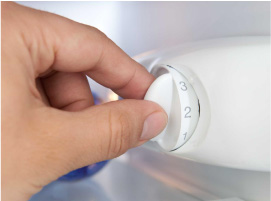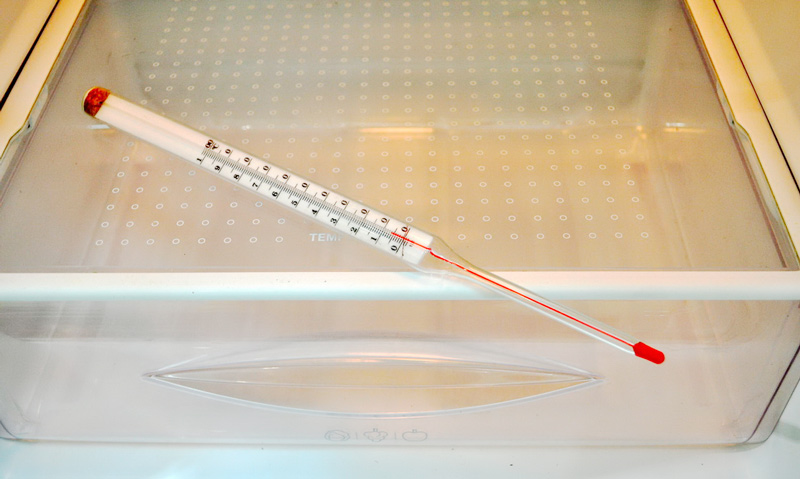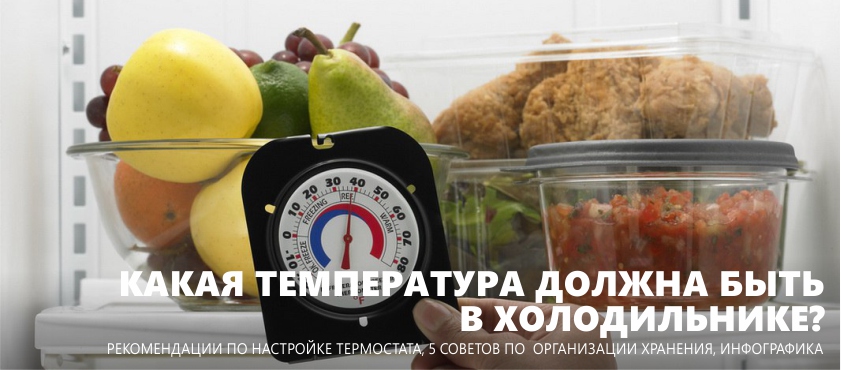There are several signs that the temperature in your refrigerator is set incorrectly:
- The food in the fridge freezes or partially freezes;
- Products just extracted from the camera seem warm to you;
- Products spoil quickly;
- Condensate forms on the walls of the refrigerator compartment;
- In the freezer melts ice.
If you notice any of these signs, the first thing you need to do is to check if the temperature is set correctly and, if necessary, use a thermometer to check if the device really supports the specified settings.
Basic principles
What temperature should be in the fridge and freezer?
- The ideal overall temperature of the refrigerator should be between +3 and + 5 ° C.
- The freezer should maintain a temperature of -18 ° C or lower.
- In the freshness zone (if there is one) the temperature is set at about 0-1 ° C.

After setting the thermostat, the desired climate will be established in 6-8 hours
These standards are suitable for storing most products, but still not for all - some supplies must be stored at zero temperature, and others - at 5-10 degrees of heat. Moreover, in different areas of the camera the cold is distributed differently, despite the specified general mode. Somewhere the climate is warmer, and somewhere - noticeably colder.
- So it turns out that even properly adjusting the thermostat, we can find in the fridge milk with ice, unexpectedly rotten eggs or lettuce leaves, which for some reason turned into gelatinous slush.
Of course, the average consumer does not need to know the subtleties of the storage conditions of all types of products, but there are some recommendations that are not difficult to remember and apply in life. This will help you a little guide in the next section of the article.
See also the material: How to properly and quickly defrost the refrigerator in 8 steps
How to store food in the refrigerator?
So, the refrigerator compartment can be divided into warm and cold zones.
- Cold areas are designed to store perishable food, and warm ones are used for vegetables, fruits, and everything else.
And now more.
Warm zones
- Door - one of the warmest places in the chamber; here the temperature is set at 10 ° C in the upper shelves and 5 ° C in the lower shelves.
What to store: sauces, mayonnaise, ketchup, soft or melted cheeses, butter, drinks (foods remain a bit soft and ready to eat).
What is undesirable to store: perishable products, for example, milk and eggs (despite the fact that manufacturers allocate doors for their storage).
- Top and middle shelves (except for those that are under the freezer) - it is always a little warmer here (about 7 ° C) than on the lower shelves, since heat tends to rise upwards.
What to store: honey, sausages, pastries, pastries, soft or processed cheeses, butter, fruits, vegetables.
What is undesirable to store: eggs, meat, fish, poultry, milk, ripe fruits and vegetables.
- Fruit and Vegetable Area - such an office with a temperature of 8 ° C is in almost all modern refrigerators.
What to store: most fruits and vegetables (except those shown in the infographic below).
Cold zones
- Freshness zone - The coldest part of the refrigerator (about 0-1 ° C), which is provided in many modern refrigerators.
- Rear part - after the freshness zone, the back of the refrigerator is the coldest, as it is located closest to the cooling elements.
- Bottom shelves - since warm air tends to rise, this zone of the refrigerating chamber is also one of the coldest (2 ° C).
What to store: meat and meat products, fish, milk, cheese, kefir, light cottage cheese and sour cream, vegetables and greens. This zone can also be used for quick cooling of beverages).
What is undesirable to store: fruits, salads, butter, soft and melted cheese (here they will become hard as a stone).
Better to remember tips on storing food in the refrigerator will help you this infographics.
Also materials on the topic:
How to check the temperature?
Some refrigerators and freezers have an external or internal sensor that accurately displays the temperature in the chambers. However, in many devices there is no such sensor, and in this case the temperature must be measured independently with a thermometer for a refrigerator. Here's how to do it:
- In a refrigerator: Put the thermometer in a glass of water and leave it on the middle shelf for at least 8 hours or overnight. The door must remain closed all the time.
- In the freezer: Put a thermometer between two packets of food and leave also for 8 hours.

Refrigerator Thermometer
And some more useful information.
- In order for the refrigerator and freezer to not lose their effectiveness, they must always be filled to at least half. If your reserves are not enough or not at all (for example, when you are on vacation), then you need to put water bottles in the cells.
- Maintain order on the shelves of the refrigerator / freezer and try to stack products so that around them there is some free space for air circulation.
- Never put hot and warm foods in the fridge. This can lead, firstly, to the formation of condensate and ice, and secondly, to overheating and engine failure. Agree, let the soup spoil better than expensive appliances. However, no-frost refrigerators with hot products are not terrible, but still keep in mind that they will increase electricity consumption and the load on the motor of the device.
- If you find that the refrigerator cools the camera unevenly or not well enough, then listen to the sound of the compressor when it is working: the working device should be quietly humming. If you do not hear this sound, it is time to call the master to repair the compressor.
- If frost or frost has formed in your refrigerator / freezer, then the device must be completely defrosted, wiped dry, and then connected, as usual.
- Which refrigerator to choose: drip or know-frost?
- 4 stages of choosing a built-in refrigerator and the nuances of its installation
- How to arrange the refrigerator in the kitchen
- How to get rid of mold in the refrigerator
- How to wash the refrigerator in 7 steps and eliminate odors with 8 home remedies
- Hood in the kitchen - what you need to pay attention to when buying
- How to remove scale from the kettle - 6 home remedies
- Clean the microwave in 5 minutes - 6 express methods
- How to embed a regular refrigerator in the headset




 (Rate the material! Already voted:10 average rating: 4,70 from 5)
(Rate the material! Already voted:10 average rating: 4,70 from 5)